
Cooking bananas are banana cultivars in the genus Musa whose fruits are generally used in cooking. They may be eaten ripe or unripe and are generally starchy. Many cooking bananas are referred to as plantains or green bananas. In botanical usage, the term "plantain" is used only for true plantains, while other starchy cultivars used for cooking are called "cooking bananas". True plantains are cultivars belonging to the AAB Group, while cooking bananas are any cultivars belonging to AAB, AAA, ABB, or BBB groups. The currently accepted scientific name for all such cultivars in these groups is Musa × paradisiaca. Fe'i bananas from the Pacific Islands are often eaten roasted or boiled, and are thus informally referred to as "mountain plantains," but they do not belong to any of the species from which all modern banana cultivars are descended.

A sausage is a type of meat product usually made from ground meat, often pork, beef, or poultry, along with salt, spices and other flavourings. Other ingredients such as grains or breadcrumbs may be included as fillers or extenders.

Glutinous rice is a type of rice grown mainly in Southeast and East Asia, Northeastern India and Bhutan which has opaque grains, very low amylose content, and is especially sticky when cooked. It is widely consumed across Asia.

Chorizo is a type of pork sausage originating from the Iberian Peninsula.
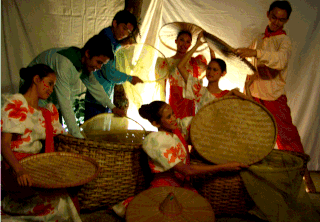
Filipino cuisine is composed of the cuisines of more than a hundred distinct ethno-linguistic groups found throughout the Philippine archipelago. However, a majority of mainstream Filipino dishes that compose Filipino cuisine are from the cuisines of the various ethnolinguistic groups and tribes of the archipelago, including the Ilocano, Pangasinan, Kapampangan, Tagalog, Bicolano, Visayan, Chavacano and Maranao ethno-linguistic groups. The style of food making and the food associated with it have evolved over many centuries from their Austronesian origins to a mixed cuisine of Chinese, Spanish and American influences, in line with the major waves of influence that had enriched the cultures of the archipelago, as well as others adapted to indigenous ingredients and the local palate.

Pancit, also spelled pansít, is a general term referring to various traditional noodle dishes in Filipino cuisine. There are numerous types of pancit, often named based on the noodles used, method of cooking, place of origin, or the ingredients. Most pancit dishes are characteristically served with calamansi.

Rice vermicelli is a thin form of a noodle. It is sometimes referred to as 'rice noodles' or 'rice sticks', but should not be confused with cellophane noodles, a different Asian type of vermicelli made from mung bean starch or rice starch rather than rice grains themselves.

A rice cake may be any kind of food item made from rice that has been shaped, condensed, or otherwise combined into a single object. A wide variety of rice cakes exist in many different cultures in which rice is eaten and are particularly prevalent in Asia. Common variations include cakes made with rice flour, those made from ground rice, and those made from whole grains of rice compressed together or combined with some other binding substance.

Colombian cuisine is a compound of the culinary traditions of the six main regions within the country. Colombian cuisine varies regionally and is particularly influenced by Indigenous Colombian, Spanish, and African cuisines, with slight Arab influence in some regions. Furthermore, being one of the most biodiverse countries in the world, Colombia has one of the widest variety of available ingredients depending on the region.

Ghanaian cuisine is the cuisine of the Ghanaian people. Ghanaian main dishes are organized around a starchy staple food, which goes with a sauce or soup containing a protein source. The main ingredients for the vast majority of soups and stews are tomatoes, hot peppers and onions. As a result, most of the Ghanaian soups and stews are red or orange in appearance.

A fishcake is a culinary dish consisting of filleted fish or other seafood minced or ground, mixed with a starchy ingredient, and fried until golden.

Honduran cuisine is a fusion of Mesoamerican (Lenca), Spanish, Caribbean and African cuisines. There are also dishes from the Garifuna people. Coconut and coconut milk are featured in both sweet and savory dishes. Regional specialties include Sopa de Caracol, fried fish, tamales, carne asada and baleadas. Other popular dishes include meat roasted with chismol and carne asada, chicken with rice and corn, and fried fish with pickled onions and jalapeños. In the coastal areas and the Bay Islands, seafood and some meats are prepared in many ways, including with coconut milk.
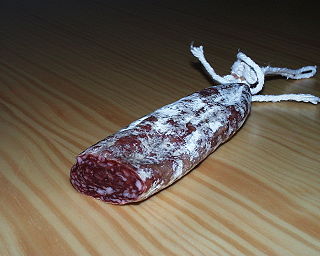
Longaniza is a Spanish sausage (embutido) similar to a chorizo and also closely associated with the Portuguese linguiça. Its defining characteristics are interpreted differently from region to region. It is popular in the cuisines of several regions of Spain, Argentina, Uruguay, Puerto Rico, Dominican Republic, El Salvador, Mexico and Chile. In the Philippines, it is called longganisa and differs greatly with hundreds of variants with different vernacular tastes and forms due to the 144 ethno-linguistic groups in the archipelago.
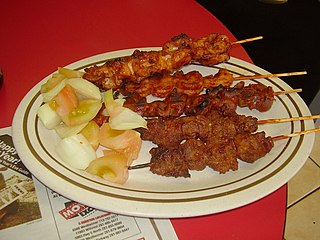
Nigerian cuisine consists of dishes or food items from the hundreds of ethnic groups that comprise Nigeria. Like other West African cuisines, it uses spices and herbs with palm or groundnut oil to create deeply flavored sauces and soups.
Belizean cuisine is an amalgamation of all ethnicities in the nation of Belize and their respectively wide variety of foods. Breakfast often consists of sides of bread, flour tortillas, or fry jacks that are often homemade and eaten with various cheeses. All are often accompanied with refried beans, cheeses, and various forms of eggs, etc. Inclusive is also cereal along with milk, coffee, or tea.
A great variety of cassava-based dishes are consumed in the regions where cassava is cultivated, and they include many national or ethnic specialities.
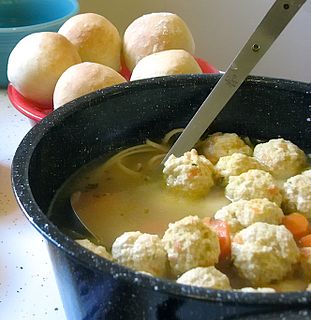
A meatball is ground meat rolled into a small ball, sometimes along with other ingredients, such as bread crumbs, minced onion, eggs, butter, and seasoning. Meatballs are cooked by frying, baking, steaming, or braising in sauce. There are many types of meatballs using different types of meats and spices. The term is sometimes extended to meatless versions based on vegetables or fish; the latter are also commonly known as fishballs.
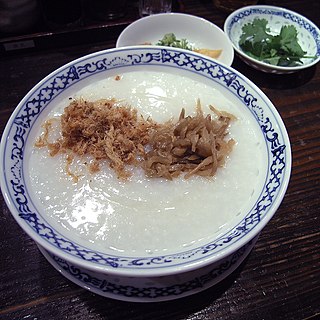
Congee or conjee is a type of rice porridge or gruel eaten in Asian countries. When eaten as plain rice congee, it is most often served with side dishes. When additional ingredients such as meat, fish, and flavourings are added while preparing the congee, it is most often served as a meal on its own, especially for people who are ill. Names for congee are as varied as the style of its preparation. Despite its many variations, it is usually a thick porridge of rice largely disintegrated after prolonged cooking in water.

Paelya or paella (Spanish), is a Philippine rice dish adapted from the Valencian paella. However, it differs significantly in its use of native glutinous rice (malagkit), giving it a soft and sticky texture, unlike the al dente texture favored in original paella. It is also characteristically topped with sliced eggs. Filipino paelya also does not use saffron, but instead use achuete (anatto), luyang dilaw, (turmeric), or kasubha (safflower).
Chorizo negrense, also known as chorizo de Bacólod, is a Filipino smoked pork sausage originating from Bacolod, Negros. It comes in two flavors: hamonado (sweet) and recado (garlicky). It can be prepared smoked in a casing, or prepared fresh without the casing. It is made with ground pork, vinegar, garlic, calamansi, soy sauce, black pepper, and coarse salt. Sugar is added to the hamonado version.

















